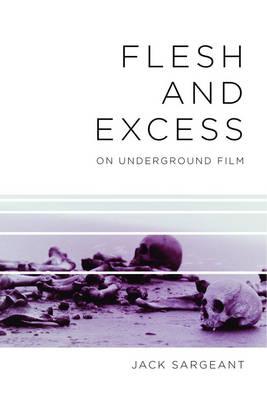by Simon Strong
Simon Strong with Jack Sargeant on Flesh & Excess: On Underground Film (Los Angeles: Amok Books, 2016).
SS: On the spur of a mad moment one does crazy things which, reviewed in the light of experience, often seem to open the floodgates of self-destruction. When Molly from OtherZine threw the idea of reviewing Jack Sargeant’s new book Flesh & Excess at me, I instantly accepted the invitation. In the cold light of after-the-fact reasoning, this was really asking for trouble. I’d known Jack for years and was a huge fan of his writing, but his taste in movies didn’t quite correspond with mine and I wasn’t sure how this ambivalence could be expressed. As it turned out it couldn’t be and the review was an incoherent rant with disturbing moralistic and reactionary conclusions… and not in a good way. Even the sporadic hilarious gags could not redeem it. I called Jack and asked his opinion and we decided to rewrite the essay as questions so that he could enjoy a right to reply. So we did. And there our troubles really began…
SS: Jack, you’re a good bloke but I’m still vague on how come you especially dig all this (for want of a better word) edgy transgressive stuff? Most of these films convey nothing to me beyond a sense of the self-importance in their own extremism. Do you feel that your interest in the cinema of social taboos (especially bodily excretions) is due to their dubious societal status or some other inherent, or transcendent, value?
JS: Flesh and Excess opens with my writing about my own obsessions with these things, and of course there’s an oblique Bible reference in there about the dog returning to its own vomit, which – in the original Bible quote – is about folly. Simultaneously, of course, a dog eating something a human may consider disgusting is just what dogs do, it’s not intrinsically wrong.
As to the films conveying nothing to you, it raises the question ‘which films?’ I mean, the book covers quite a few underground films and touches on underground artists, musicians and so on, and I am not sure they can all be said to ‘convey nothing’. Perhaps more interestingly to anyone wanting to look in psychological terms at my own writing, I have an attraction to the nihilistic aspects that characterise some of these films. I do, quite genuinely, have a deep rooted fascination with limits and transgression. As to the film’s having a sense of ‘self-importance’ at their own extremism, I feel the films I look at reflect my concerns, most of the filmmakers have made other works that may be said to focus elsewhere. Also, more directly, I think there’s nothing wrong with work having nothing but extremism to offer it is not something that needs to be explained or justified.
Finally, I am not sure that they are necessarily extreme, perhaps excess isn’t quite the same as extreme… To address your second point, regarding the metaphysical and philosophical aspects, I have an issue with some notions of transcendence, but I also think there is a quality to certain things, for example the orgasm as a moment of transcendent possibility that is important to recognise. Now, is there a moment of transcendent possibility in bodily functions or ecstatic activities in which the individual is both affirmed and erased? I think that there could be. To me that’s really interesting. I also think that taboo itself is fascinating, and it’s something that I think has to be negotiated repeatedly.
SS: Do you consider the social taboos of dogmatic control systems more or less arbitrary? If such are arbitrary, then where is the value in violating them? Surely that allows the adversary to set the terms and conditions of the confrontation. E.g. If a Black Mass is simply an inversion or mirror-image of a Christian service, then it differs only in its mode of presentation. How can that be subversive?
JS: I think there are very different kinds of taboos, which shift from the psychological to the cultural to the social. Although I am not sure we can separate these elements neatly, and I am not suggesting they exist in clearly defined areas. Is there a value in violating taboo? I think that depends on the taboo and the method of violation, and of course the nature of any value, or value itself. To use your example of the Black Mass as a reversal of the Christian service, I would see that as theatrical, it’s a performance that I would suggest is designed to offend the conservative aspects of the church and empower the participants. So, on that level, I would agree with you it’s a mirror image. But it is more than this, because it is linked with a form of empowerment for the participants. If we are to recognise that some conservative forces invest in binary thinking, then playing with reversing that binary can be seen as a form of political challenge to specific manifestations of control. In that sense, the violation of a taboo through reversal can have a powerful effect. Look at the Satanic Temple for instance, with their campaign to have a statue of Baphomet placed next to a statue depicting the Ten Commandments, an act designed I think to showcase the need to respect the rights of all religions and the separation of church and state.
SS: A canon of work based on primal (and therefore common) physiological responses will always enjoy a wide audience given preconditions of distribution, q.v. the popularity of sexual pornography. The type of extreme cinema discussed here is distinguished primarily by its extremity and thus may appeal strongly to other cultural forms predicated on extremity, e.g. industrial music or heavy metal and punk in the olden days. Those headbangers used to love their Guinea Pig films! Thus the extremism of the material is the very thing that renders it accessible to its primary demographic. Do you think that’s a tautology or an oxymoron?
JS: Ha! I’m not sure. I mean, there’s always an argument about any manifestation of culture that it only speaks to those who already have some idea about that culture. But this said, enough people see works that they may not be familiar with and are challenged.
SS: The book is subtitled “On Underground Film” like it’s trying to build a canon, but it deals overwhelmingly with a specific (heavily US-centric) current thereof. This actually really bothers me as it wouldn’t be apparent to newcomers to the field and could easily mislead (and/or dissuade) potential viewers as to the wide variety of underground currents that flourish around the world. Eh?
JS: The first part of the book offers a context on the idea of underground film, challenging some definitions I think and positioning that which follows. But there are several issues with this question, firstly the idea that a book should build a canon or be complete, which is obviously impossible, I mean, there’s three William Burroughs biographies – and two are by the same person – so clearly the idea of a complete text is impossible, there’s always gaps, spaces, and so on. Books aren’t about closure but about opening ideas up. I think, to me, “On Underground Film“ as a subtitle refers to where the “Flesh and Excess” is located in the text, so, for instance, it’s not located in the horror genre. I also think that numerous book titles use general terms such as ‘underground film’, or even, ‘French cinema’, as a way to give the reader a general idea of narrative location, but it doesn’t mean the book is necessarily complete, merely that it is part of that area of research or contributes to that particular area. Regarding the US-centric aspect, I’m not sure how true that is, the films discussed that offer a context include some that come from across the world (i.e. Coum Transmissions’ After Cease to Exist is from Britain, Un Chien Andalou is French), but the explosion of underground film around the eighties and nineties that I discuss emerged around Film Threat and Film Threat Video Guide and was from the USA, but there are others from the UK that I mention in passing too. I’m not sure as a writer it’s my job to alert the reader to all the currents and potentialities that exist out there. On one hand, there’s always room for further study, on the other hand, some books such as Duncan Reekie’s excellent Subversion: the Definitive History of Underground Cinema deal with the rebirth of the underground in the UK.
SS: Given the graphic nature of the material I was hoping for more sexy pictures. The pictures are interesting and well selected but not as strong as the text content. (NB: It would be refused classification in Australia if they were!) Actually “more sexy pictures” would just have been of people spewing and shitting blood so maybe that’s a bonus. As it is, it’s mostly safe to read on a bus. What do you reckon?
JS: Ha ha ha! I used to read all manner of books [with and without pictures] on the bus and train. I’m probably more circumspect than I used to be. But, regarding images, I think there’s enough in there, and with the internet, people can search for others. Remember, I used to write for Bizarre magazine in the nineties. It was a lot of fun, but I’ve done that, too, and I hope my words carry the strength of the films and the ideas I evoke, so more extreme images may just become a kind of psychic-black-spot rather than complimentary to the writing.
SS: Was the book secretly designed by some kind of esoteric cabal to facilitate a potential cinema studies course that would hoover up the maximum number of students? Since it fucking would.
JS: I have only very rarely been able to teach courses on the films I write about, sadly. I wish somebody would give me a regular part-time gig teaching underground film, both the stuff in Flesh and Excess and wider forms of non-mainstream cinema. I hope it would interest students!
SS: Near the end (1:49:00) of Adam Curtis’s Bitter Lake (2015), a “documentary” about the history of foreign intervention in Afghanistan, there’s a scene where a (female) lecturer in conceptual art (presumably sent by the British Council or similar) is explaining to a roomful of confused-looking Afghan students about the cultural significance of Marcel Duchamp exhibiting a urinal in an art gallery. “Does anyone know what it is? I don’t expect the ladies to know,” she says. No-one looks like they want to be there. What’s that all about then?
JS: I think that the ready-made was a direct response to a specific European history of art and culture. I love R Mutt, but as a piece of artwork it had and fulfilled a very specific function. I don’t know if it translates culturally without a larger context.


